"Shri Panchmukhi Hanuman: The Divine Protector
JAI SHREE RAM
Unveiling Strength and Grace."
"Lord Ganesha: The Remover of Obstacles.
The Bringer of Blessings.."
"Lord Narasimha: The Protector of Devotees.
The Destroyer of Evil.."
"Lord Jagannath: The Lord of the Universe.
The Embodiment of Compassion and Joy.."
"Goddess Durga: The Protector of Righteousness
The Embodiment of Strength and Courage.."
"Sai Baba: The Symbol of Love and Compassion.
The Guide to Peace and Devotion.."
Sri Panchamukhi Hanuman: The Embodiment of Divine Strength and Devotion
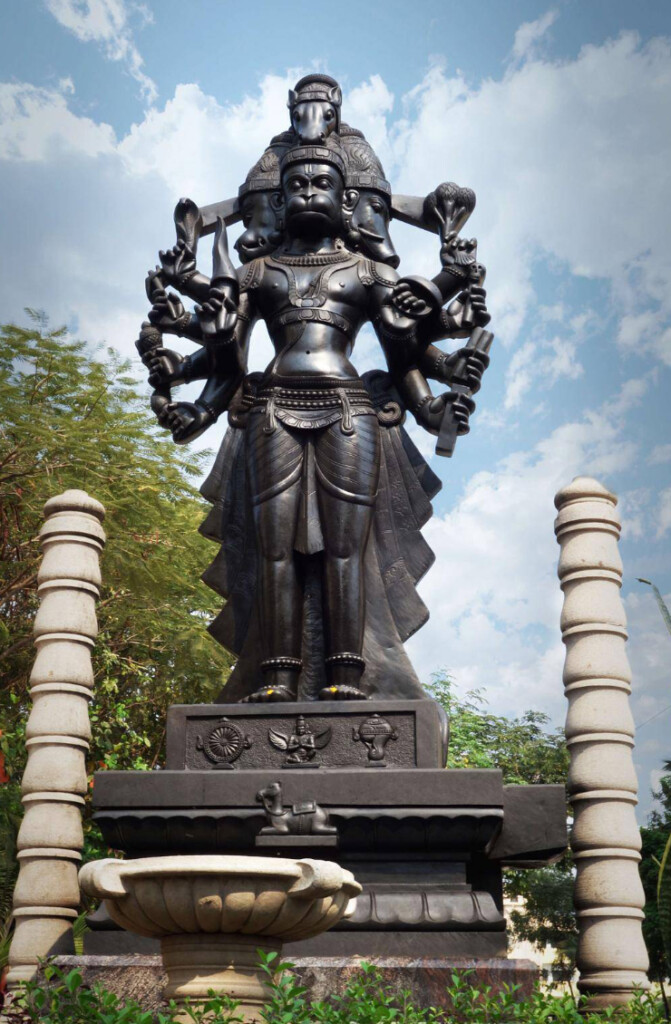
There are 10 forms of Hanuman worship in Kali Yuga. Among them, the Panchamukha Hanuman form is very special. This form is called Hanuman’s universal form.
During the battle between Rama and Ravana, during the night, Mahiravana kidnapped Rama and Lakshmana, took them with him to the underworld. Hanuma, upon learning this, asked Vibhishana about Mahiravana. At that time, Vibhishana said that Mahiravana had the same strength as Ravana, was a wicked person, could not die, and his life was tied to his kingdom, which is located in a secret place in the underworld with five lamps. These five lamps could not be extinguished at the same time by a single person. It was only then that the wicked Mahiravana was said to have died.
Hearing this, Hanuma immediately went to the place with the five lamps and, using his power and intelligence, found the secret place with the lamps. The five lamps were located in the following directions: 1 in the East, 2 in the South, 3 in the West, 4 in the North, and 5 above. A normal person would not be able to extinguish these lamps. However, Hanuma, in his Rudra form, the son of the wind god, who is the disciple of the sun god, a scholar in the nine forms of

There are 10 forms of Hanuman worship in Kali Yuga. Among them, the Panchamukha Hanuman form is very special. This form is called Hanuman’s universal form.
During the battle between Rama and Ravana, during the night, Mahiravana kidnapped Rama and Lakshmana, took them with him to the underworld. Hanuma, upon learning this, asked Vibhishana about Mahiravana. At that time, Vibhishana said that Mahiravana had the same strength as Ravana, was a wicked person, could not die, and his life was tied to his kingdom, which is located in a secret place in the underworld with five lamps.These five lamps could not be extinguished at the same time by a single person. It was only then that the wicked Mahiravana was said to have died.Hearing this, Hanuma immediately went
to the place with the five lamps and, using his power and intelligence, found the secret place with the lamps. The five lamps were located in the following directions: 1 in the East, 2 in the South, 3 in the West, 4 in the North, and 5 above.
A normal person would not be able to extinguish these lamps. However, Hanuma, in his Rudra form, the son of the wind god, who is the disciple of the sun god, a scholar in the nine forms of vyakarana, at the time of learning from the sun god, would move in a way that was favorable to the sun god and practice the necessary disciplines to absorb the heat, eventually becoming a great scholar and a source of light, thus gaining the power over the eight siddhis.
(Ashta siddhi navasidhike dhaatha) Such anjaneya Swamy, using his intellect and yogic powers, invoked and controlled the five elements in his body through his eight siddhis.
These five elements, combining their powers, made Hanuman take a new form. The default face (Hanuma) representing the element of wind, and the other 4 elements of fire, water, earth, and sky, forming the Panchamukha Hanuman.
This form consists of the East being Hanuma, South being Simha, West being Garuda, North being Varaha, and the Top being Hayagreeva (horse). In this way, the form of the Lord, with five heads and ten arms, wielding ten weapons, shines with divine light.
Hanuman extinguished the five lamps simultaneously with his five faces. With that, Mahiravana died. In this Panchamukha Hanuman,
worshipping the Eastern face, in the default(Hanuma) form brings health, destruction of enemies, elimination of planetary afflictions, and victory.
Worshipping the Southern face in the form of a lion removes all troubles from ghosts and spirits, removes fears, pain, and stops evil practices.
Worshipping the Western face in the form of Garuda removes obstacles, ensures the success of all endeavors, removes snake-related issues, and cures poisoning diseases.
Worshipping the Northern face in the form of Varaha increases wealth, clears debts, increases all types of prosperity, and eliminates poverty.
Worshipping the sky face in the form of Hayagreeva increases knowledge, clarity, and intellect. It bestows power to students for the development of their studies.
This Panchamukha Hanuman form is considered Anjaneya’s Vishwaroopam.
Join us in this sacred journey and be a part of the spiritual legacy of Sri Panchamukhi Hanuman.
vyakarana, at the time of learning from the sun god, would move in a way that was favorable to the sun god and practice the necessary disciplines to absorb the heat, eventually becoming a great scholar and a source of light, thus gaining the power over the eight siddhis.
(Ashta siddhi navasidhike dhaatha) Such anjaneya Swamy, using his intellect and yogic powers, invoked and controlled the five elements in his body through his eight siddhis.
These five elements, combining their powers, made Hanuman take a new form. The default face (Hanuma) representing the element of wind, and the other 4 elements of fire, water, earth, and sky, forming the Panchamukha Hanuman.
This form consists of the East being Hanuma, South being Simha, West being Garuda, North being Varaha, and the Top being Hayagreeva (horse). In this way, the form of the Lord, with five heads and ten arms, wielding ten weapons, shines with divine light. Hanuman extinguished the five lamps simultaneously with his five faces. With that, Mahiravana died.
In this Panchamukha Hanuman, worshipping the Eastern face, in the default(Hanuma) form brings health, destruction of enemies, elimination of planetary afflictions, and victory. Worshipping the Southern face in the form of a lion removes all troubles from ghosts and spirits, removes fears, pain, and stops evil practices. Worshipping the Western face in the form of Garuda removes obstacles, ensures the success of all endeavors, removes snake-related issues, and cures poisoning diseases. Worshipping the Northern face in the form of Varaha increases wealth, clears debts, increases all types of prosperity, and eliminates poverty. Worshipping the sky face in the form of Hayagreeva increases knowledge, clarity, and intellect. It bestows power to students for the development of their studies.
This Panchamukha Hanuman form is considered Anjaneya’s Vishwaroopam.
Join us in this sacred journey and be a part of the spiritual legacy of Sri Panchamukhi Hanuman.
Experience Divine Protection and Strength with Prahlada sahita Narasimha Swamy
Experience Divine Protection and Strength with Prahlada sahita Narasimha Swamy
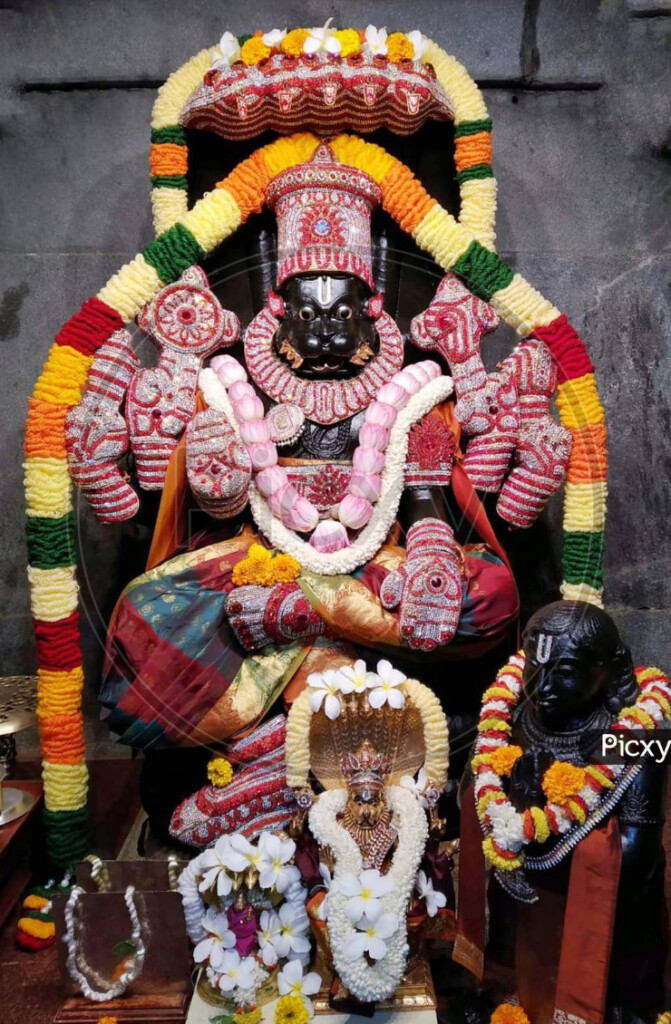
This beautiful depiction is of Prahlada sahita Narasimha Swami, the fourth incarnation of Lord Vishnu, where he appears in a divine, yet fierce form with the head of a lion and the body of a human, signifying the destruction of evil and the protection of righteousness.
1. Protector of Devotees: Sri Narasimha Swamy took his fierce form to protect his ardent devotee Prahlada from the demon king Hiranyakashipu. His divine role is to shield all true devotees from harm, evil, and injustice, especially those who surrender with faith.
2. Destroyer of Evil: He annihilates adharma (unrighteousness) and those who harm innocent beings. His form represents divine wrath against cruelty, falsehood, and pride.
3. Bestower of Courage and Fearlessness: Devotees worship him to overcome fear, anxiety, and inner turmoil. He instills bravery, mental strength, and resilience.
4. Healer and Guardian Against Disease and Negativity: The fierce energy of Narasimha is known to cure illnesses, ward off black magic, evil spirits, and planetary doshas (afflictions) like Rahu-Ketu or Sarpa Dosha.
5. Granter of Peace, Prosperity, and Moksha: With Goddess Lakshmi on his lap, he is also a giver of wealth, good fortune, and spiritual progress. His grace ensures material success and liberation (moksha).
6. Upholder of Dharma (Righteousness): He ensures balance in the universe by protecting good and punishing the wicked. His very presence reminds devotees to live a life of truth and integrity.
7. Spiritual Uplifter: Lakshmi Narasimha guides seekers on the path of devotion, knowledge, and self-realization. Worship of this form is said to destroy past karmas and purify the soul.
“Ugram Viram Maha Vishnum Jvalantam Sarvato Mukham
Nrisimham Bhishanam Bhadram Mrityor Mrityum Namamyaham”
This beautiful depiction is of Prahlada sahita Narasimha Swami, the fourth incarnation of Lord Vishnu, where he appears in a divine, yet fierce form with the head of a lion and the body of a human, signifying the destruction of evil and the protection of righteousness.
1. Protector of Devotees:
Sri Narasimha Swamy took his fierce form to protect his ardent devotee Prahlada from the demon king Hiranyakashipu. His divine role is to shield all true devotees from harm, evil, and injustice, especially those who surrender with faith.
2. Destroyer of Evil:
He annihilates adharma (unrighteousness) and those who harm innocent beings. His form represents divine wrath against cruelty, falsehood, and pride.
3. Bestower of Courage and Fearlessness:
Devotees worship him to overcome fear, anxiety, and inner turmoil. He instills bravery, mental strength, and resilience.

4. Healer and Guardian Against Disease and Negativity:
The fierce energy of Narasimha is known to cure illnesses, ward off black magic, evil spirits, and planetary doshas (afflictions) like Rahu-Ketu or Sarpa Dosha.
5. Granter of Peace, Prosperity, and Moksha:
With Goddess Lakshmi on his lap, he is also a giver of wealth, good fortune, and spiritual progress. His grace ensures material success and liberation (moksha).
6. Upholder of Dharma (Righteousness):
He ensures balance in the universe by protecting good and punishing the wicked. His very presence reminds devotees to live a life of truth and integrity.
7. Spiritual Uplifter:
Lakshmi Narasimha guides seekers on the path of devotion, knowledge, and self-realization. Worship of this form is said to destroy past karmas and purify the soul.
Lord Ganesha: The Lord of the Universe
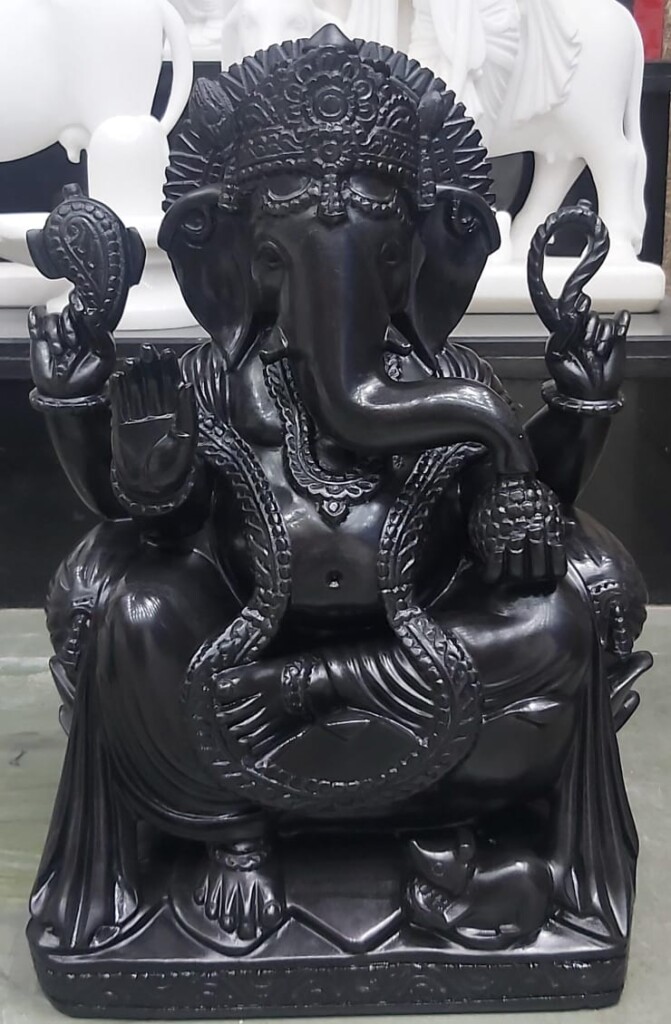
Lord Ganesha, also known as Vinayaka or Pillaiyar, is the beloved elephant-headed god worshiped as the remover of obstacles and the giver of wisdom and success. With his unique form and gentle smile, he holds a special place in the hearts of millions across India, especially in the South.
He is easily recognized by his elephant head, large ears, and pot belly, each symbolizing deep spiritual meanings. His big ears teach us to listen more, his trunk shows adaptability, and his broken tusk reminds us that sacrifice is part of wisdom.
Devotees begin all important tasks—be it a wedding, journey, or new business—by praying to Lord Ganesha first. His blessings are believed to clear the path ahead and bring peace, clarity, and prosperity.
Each year, festivals like Vinayaka Chaturthi are celebrated with great devotion, where beautifully crafted Ganesha idols are worshiped at home and in public, then joyfully immersed in water with prayers for his return.
Worshiping Lord Ganesha brings calmness, courage, and confidence. His peaceful presence assures us that we are never alone—he walks with us, guiding and protecting us through every step of life.
Goddess Maha lakshmi : The Powerful Protector
Goddess Mahalakshmi, in the sacred traditions of South India, is revered as the eternal consort of Lord Vishnu, the Supreme Preserver of the Universe. She is not merely a symbol of material wealth, but the very source of all auspiciousness (Mangalam) – encompassing wealth, fertility, grace, beauty, courage, and spiritual power. Her presence ensures balance, harmony, and the smooth functioning of life and dharma.
She is addressed with utmost reverence as Sri Devi, the embodiment of Shakti (divine feminine energy), and is always portrayed alongside Lord Vishnu in temples and scriptures. In temples like Srirangam, Tirupati, and Kanchipuram, she is enshrined as Thayar (the Divine Mother), who intercedes with compassion for the devotees’ welfare.
🌸 Iconography – Visual and Symbolic Attributes
In South Indian temples and traditional paintings (Tanjore, Kalamkari, etc.), Goddess Mahalakshmi is typically portrayed in an elegant, benevolent, and regal form. Her depiction is filled with spiritual symbolism:
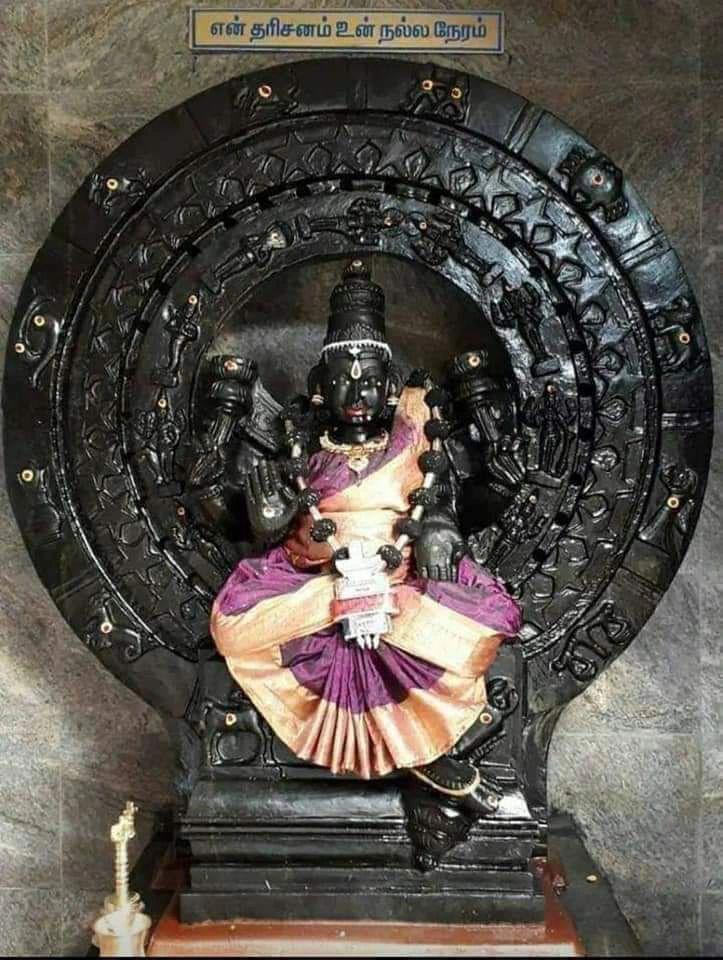

Goddess Mahalakshmi, in the sacred traditions of South India, is revered as the eternal consort of Lord Vishnu, the Supreme Preserver of the Universe. She is not merely a symbol of material wealth, but the very source of all auspiciousness (Mangalam) – encompassing wealth, fertility, grace, beauty, courage, and spiritual power. Her presence ensures balance, harmony, and the smooth functioning of life and dharma.
She is addressed with utmost reverence as Sri Devi, the embodiment of Shakti (divine feminine energy), and is always portrayed alongside Lord Vishnu in temples and scriptures.
🌸 Iconography – Visual and Symbolic Attributes
In South Indian temples and traditional paintings (Tanjore, Kalamkari, etc.), Goddess Mahalakshmi is typically portrayed in an elegant, benevolent, and regal form. Her depiction is filled with spiritual symbolism:
🪷 Posture and SeatShe is usually seated majestically on a full-bloomed lotus, symbolizing spiritual purity and detachment. In many representations (especially Gaja Lakshmi), two white elephants are seen pouring sacred water over her from golden pots, representing royal blessing and fertility. ✨ Form and Features
Complexion: Her skin glows with a radiant golden or coral-red hue, representing divine energy, wealth, and warmth.
Face: Her face is serene, kind, and motherly – filled with compassion, yet commanding with divine authority.
Eyes: Large and slightly elongated, filled with karuna (compassion) and wisdom.
💫 Arms and Symbolism
Goddess Lakshmi is typically depicted with four arms, each representing a key goal of human life – Dharma (righteousness), Artha (wealth), Kama (desire), Moksha (liberation).
Upper Right Hand: Holds a lotus flower – signifying beauty, purity, and spiritual enlightenment.
Upper Left Hand: May hold a kalasha (pot of nectar/wealth) or another lotus.
Lower Right Hand: Shows the Abhaya Mudra – the gesture of reassurance and protection.
Lower Left Hand: In Varada Mudra, symbolizing the granting of boons and prosperity. Sometimes, you may see gold coins flowing from her palm, representing endless blessings and abundance.
👑 Adornments
Mahalakshmi is richly adorned with golden jewelry typical of South Indian temple tradition: Oddiyanam (waist belt), Vanki (armbands), Kaasu Maalai (coin necklace), Maang Tikka, Jhumkas, and heavy bangles.She wears a tall, ornate crown (Kireetam), signifying her divine sovereignty.
Her clothing is usually a rich silk saree in hues of red, green, or gold – all of which are considered auspicious in South Indian culture.
🪷 Posture and Seat
She is usually seated majestically on a full-bloomed lotus, symbolizing spiritual purity and detachment.
In many representations (especially Gaja Lakshmi), two white elephants are seen pouring sacred water over her from golden pots, representing royal blessing and fertility.
✨ Form and Features
Complexion: Her skin glows with a radiant golden or coral-red hue, representing divine energy, wealth, and warmth.
Face: Her face is serene, kind, and motherly – filled with compassion, yet commanding with divine authority.
Eyes: Large and slightly elongated, filled with karuna (compassion) and wisdom.
💫 Arms and Symbolism
Goddess Lakshmi is typically depicted with four arms, each representing a key goal of human life – Dharma (righteousness), Artha (wealth), Kama (desire), Moksha (liberation).
Upper Right Hand: Holds a lotus flower – signifying beauty, purity, and spiritual enlightenment.
Upper Left Hand: May hold a kalasha (pot of nectar/wealth) or another lotus.
Lower Right Hand: Shows the Abhaya Mudra – the gesture of reassurance and protection.
Lower Left Hand: In Varada Mudra, symbolizing the granting of boons and prosperity. Sometimes, you may see gold coins flowing from her palm, representing endless blessings and abundance.
👑 Adornments
Mahalakshmi is richly adorned with golden jewelry typical of South Indian temple tradition: Oddiyanam (waist belt), Vanki (armbands), Kaasu Maalai (coin necklace), Maang Tikka, Jhumkas, and heavy bangles.She wears a tall, ornate crown (Kireetam), signifying her divine sovereignty.
Her clothing is usually a rich silk saree in hues of red, green, or gold – all of which are considered auspicious in South Indian culture.
Navagraha Devatas: The Celestial Forces Guiding Human Destiny
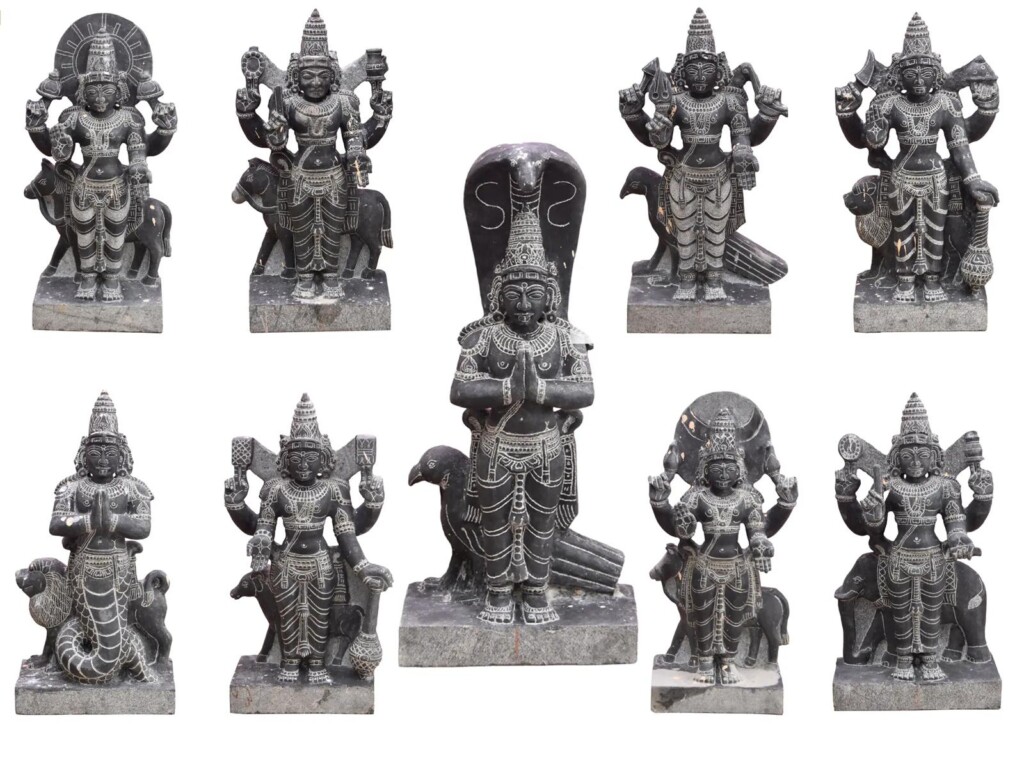
This is a Navagraha statue set — a traditional depiction of the nine planetary deities (Navagrahas) in Hindu astrology and temple worship. These deities are carved from black stone and each one is shown with specific iconography, weapons, and vahanas (vehicles).
Let me explain each one from top-left to bottom-right based on standard iconographic features:

This is a Navagraha statue set — a traditional depiction of the nine planetary deities (Navagrahas) in Hindu astrology and temple worship. These deities are carved from black stone and each one is shown with specific iconography, weapons, and vahanas (vehicles).
Let me explain each one from top-left to bottom-right based on standard iconographic features:
🔵 Top Row (Left to Right):
-
Surya (Sun God)
-
Features: Standing with two lotuses in hand, often shown with a halo behind the head.
-
Vahana: Seven horses or a chariot.
-
Role: Represents soul, health, and leadership.
-
-
Chandra (Moon God)
-
Features: Calm expression, holding a lotus or a club.
-
Vahana: Antelope or chariot pulled by ten horses.
-
Role: Controls emotions, mind, and fertility.
-
-
Mangal (Mars)
-
Features: Holding weapons like mace or trident.
-
Vahana: Ram.
-
Role: Represents courage, aggression, and strength.
-
-
Budha (Mercury)
-
Features: Holding sword, shield, and staff.
-
Vahana: Lion or elephant.
-
Role: Associated with intellect, communication, and trade.
-
🟡 Middle (Center Figure):
-
Guru (Jupiter)
-
Features: Hands in blessing and teaching posture, often holding a rosary and book.
-
Vahana: Seated on or accompanied by a swan or elephant.
-
Role: Represents wisdom, education, and dharma.
-
🔴 Bottom Row (Left to Right):
-
Shukra (Venus)
-
Features: Two or four arms, often with a staff or scripture.
-
Vahana: Horse or crocodile.
-
Role: Associated with love, luxury, art, and marriage.
-
-
Shani (Saturn)
-
Features: Dark complexion, carries bow, arrow or mace.
-
Vahana: Crow or vulture.
-
Role: Represents discipline, karma, and longevity.
-
-
Rahu
-
Features: Serpent head, often holding a sword or shield.
-
Vahana: Chariot pulled by black horses.
-
Role: Associated with illusion, ambition, and unexpected change.
-
-
Ketu
-
Features: Serpent lower body, often depicted with a flag or sword.
-
Vahana: Vulture or dog.
-
Role: Represents moksha (liberation), detachment, and past karma.
-
🔮 Spiritual Significance of Navagraha Worship:
-
These deities are worshipped to balance planetary influences in one’s horoscope.
-
Temples across South India (e.g., Navagraha temples in Tamil Nadu) feature these statues in special shrines.
-
Performing Navagraha pooja is believed to remove obstacles and grant success in various aspects of life like career, health, marriage, and education.
🔵 Top Row (Left to Right):
-
Surya (Sun God)
-
Features: Standing with two lotuses in hand, often shown with a halo behind the head.
-
Vahana: Seven horses or a chariot.
-
Role: Represents soul, health, and leadership.
-
-
Chandra (Moon God)
-
Features: Calm expression, holding a lotus or a club.
-
Vahana: Antelope or chariot pulled by ten horses.
-
Role: Controls emotions, mind, and fertility.
-
-
Mangal (Mars)
-
Features: Holding weapons like mace or trident.
-
Vahana: Ram.
-
Role: Represents courage, aggression, and strength.
-
-
Budha (Mercury)
-
Features: Holding sword, shield, and staff.
-
Vahana: Lion or elephant.
-
Role: Associated with intellect, communication, and trade.
-
🟡 Middle (Center Figure):
-
Guru (Jupiter)
-
Features: Hands in blessing and teaching posture, often holding a rosary and book.
-
Vahana: Seated on or accompanied by a swan or elephant.
-
Role: Represents wisdom, education, and dharma.
-
🔴 Bottom Row (Left to Right):
Shukra (Venus)
Features: Two or four arms, often with a staff or scripture.
Vahana: Horse or crocodile.
Role: Associated with love, luxury, art, and marriage.
Shani (Saturn)
Features: Dark complexion, carries bow, arrow or mace.
Vahana: Crow or vulture.
Role: Represents discipline, karma, and longevity.
Rahu
Features: Serpent head, often holding a sword or shield.
Vahana: Chariot pulled by black horses.
Role: Associated with illusion, ambition, and unexpected change.
Ketu
Features: Serpent lower body, often depicted with a flag or sword.
Vahana: Vulture or dog.
Role: Represents moksha (liberation), detachment, and past karma.
🔮 Spiritual Significance of Navagraha Worship:
These deities are worshipped to balance planetary influences in one’s horoscope.
Temples across South India (e.g., Navagraha temples in Tamil Nadu) feature these statues in special shrines.
Performing Navagraha pooja is believed to remove obstacles and grant success in various aspects of life like career, health, marriage, and education.
Support the Sri Panchamukhi Hanuman Temple
Be a part of something divine! Your contribution will help us build the Sri Panchamukhi Hanuman Temple — a sacred space for worship, reflection, and community connection. Every donation, big or small, brings us closer to creating a spiritual sanctuary for all.
SRI PANCHAMUKHI HANUMAN
Be part of our sacred mission to build the Sri Panchamukhi Hanuman Temple. Experience inner peace, connect with the divine, and become a pillar of this spiritual journey. Join our community, stay updated, and contribute to something meaningful. Sign up now to stay connected and support the temple's construction.
